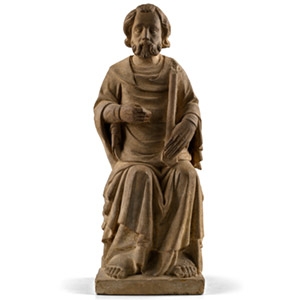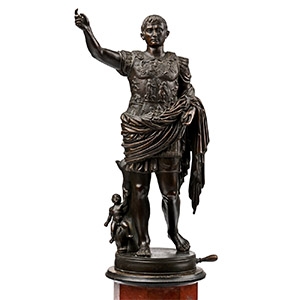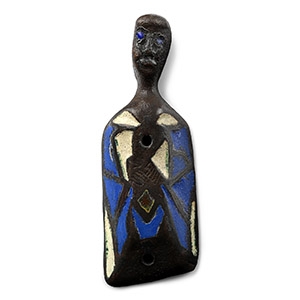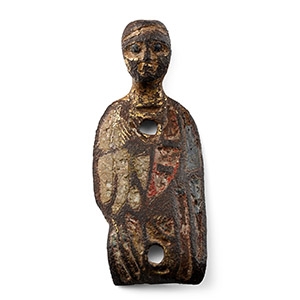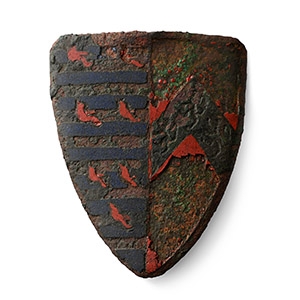Home > Auctions > 9 - 17 September 2025
Ancient Art, Antiquities, Books, Natural History & Coins
From the collection of Mrs Chester D. Tripp.
Gifted to the Cleveland Museum of Art in honour of William Wixom, 1979.
Deaccessioned by the museum prior to 2000.
Ex central London gallery.
This lot has been checked against the Interpol Database of stolen works of art and is accompanied by a search certificate number no.12836-240248.
This lot has been cleared against the Art Loss Register database, and is accompanied by an illustrated lot declaration signed by the Head of the Antiquities Department, Dr Raffaele D'Amato.
Cf. for similar gilt plaque with Annunciation scene, see the Metropolitan Museum of Art, New York, inv.no.56.43.
Sotheby's, New York, USA, 27 January 2011, no.394.
Ex central London, UK, gallery.
This lot has been checked against the Interpol Database of stolen works of art and is accompanied by a search certificate number no.12831-240244.
This lot has been cleared against the Art Loss Register database, and is accompanied by an illustrated lot declaration signed by the Head of the Antiquities Department, Dr Raffaele D'Amato.
Cf. similar image in MET inv.no. 64.312, in Wixom, W., Medieval Sculpture at the Cloisters, The Metropolitan Museum of art Bulletin, volume XLVI, 1988-1989, p.25.
From the private collection of a London gentleman, from his grandfather's collection formed before the early 1970s.
This lot has been checked against the Interpol Database of stolen works of art and is accompanied by a search certificate number no.12890-240328.
This lot has been cleared against the Art Loss Register database, and is accompanied by an illustrated lot declaration signed by the Head of the Antiquities Department, Dr Raffaele D'Amato.
Acquired on the European art market.
Private collection, London, UK.
Accompanied by an academic report by Dr Raffaele D'Amato.
This lot has been checked against the Interpol Database of stolen works of art and is accompanied by a search certificate number no.12844-240885.
This lot is accompanied by an illustrated lot declaration signed by the Head of the Antiquities Department, Dr Raffaele D'Amato.
For a prototype icon see Buckton, R., Treasures of Byzantine Art and culture, London, 1994, fig.223.
Even after the fall of Constantinople, icons painted on wood remained the principal object of devotion for Orthodox Christians both within the former borders of Byzantium and wherever the commonwealth of the Eastern Roman Empire left its traces. The painted icons are still today used by the Orthodox for personal devotion, for display in churches on feast days, and to decorate the iconostasis (partition) of the church, i.e. the dividing wall erected in front of the Bema, where the sacred altar of the Apse is collocated. The Archangel Michael was the commander of the Heavenly Host, and venerated by military men and the common people as one of the most powerful protector saints.
Acquired on the European art market.
Private collection, London, UK.
Accompanied by an academic report by Dr Raffaele D'Amato.
This lot has been checked against the Interpol Database of stolen works of art and is accompanied by search certificate no.12792-240886.
This lot has been cleared against the Art Loss Register database, and is accompanied by an illustrated lot declaration signed by the Head of the Antiquities Department, Dr Raffaele D'Amato.
Cf. for prototype of these icons, Royal Academy of Arts, Exhibition Catalogue, From Byzantium to El Greco, London, 1980, no 45.
Korban, H.K., Icons from the Orthodox World, A private collection, London, 2013, p.54.
The painting belongs to the 16th century Veneto-Cretan School. The Venetians, masters of Crete since the 13th century AD, encouraged their Greek subjects to keep and develop their Christian religious traditions while at the same time bringing them into contact with intellectual trends current in Western Europe. The new artistic currents and the great Byzantine tradition were transferred to the Island which was able to adopt that tradition and create a new one. The icon painters were organised into a guild - the Scuola di San Luca - which promoted a specific post-Byzantine style through a system of instruction and apprenticeship which lasted for more than two centuries.
From the private collection of a S.W. London gentleman, acquired in the 1970s.
This lot is accompanied by an illustrated lot declaration signed by the Head of the Antiquities Department, Dr Raffaele D'Amato.
An elegant 19th century detailed replica of the marble statue of Augustus discovered in 1863 during archaeological excavations at the Villa Livia owned by Augustus's wife, Livia Drusilla, at Prima Porta on the Via Flaminia, 12km north of Rome. The original full-length statue portrays an idealised image of Augustus in the role of imperator, commander of military forces, in contrapposto stance derived from Greek athletic statues of the 5th century BC. This statue represents Augustus in the act of adlocutio, addressing his troops, also seen on the reverse of the dupondii of Germanicus (RIC Gaius 57). Augustus is represented as a great general, a powerful orator, eternally youthful, with the body of a Greek athlete, with a support statuette of Cupid seated on a dolphin alluding to his divine ancestry from Venus through his formal adoption by Julius Caesar. The main element of the statue is the highly decorated cuirass with sphinx-decorated shoulder straps and paludamentum covered with figures arranged in three sections: Caelus, or sky-god at the apex; below him the sun-god Sol in his four-horse chariot and Aurora riding on the back of a female celestial personification; central section with figures of Hispania on the extreme left and another captive female, possibly Gallia, to the right; beneath, Apollo with lyre riding on a winged griffin and Diana on the back of a stag, with Tellus (Mother Earth) cradling two babies below, all framing the most important figures of the cuirass: on the right a Parthian military warrior (identified as Phraates IV) holding a Roman standard towards a helmeted and cuirassed Roman soldier accompanied by a she-wolf or dog (identified as Augustus-Aeneas, Tiberius, Mars or the personification of exercitus Romanus, the Roman army, an allusion to the return of the Roman standards in 20 BC, captured by the Parthians from the Roman general Marcus Licinius Crassus after his ignominious defeat at Carrhae in 53 BC. The statue thus commemorates Augustus’s victory over Parthia. Augustus made much of this, the first significant victory after Actium in 31 BC. Historical sources state that Phraates IV restored the standards to Augustus in 20 BC, although Suetonius reports that it was Tiberius who served as the intermediary for the transfer (Tiberius 9.1).
Acquired on the European art market.
Private collection, London, UK.
This lot is accompanied by an illustrated lot declaration signed by the Head of the Antiquities Department, Dr Raffaele D'Amato.
Francis of Paola (1416-1507) was an Italian monk and the founder of the Order of Minims, a religious order focused on humility, penance, and charity. Born in Paola, Calabria, he was known for his ascetic lifestyle and deep spirituality. Francis was credited with performing miracles, including healing the sick and even crossing the sea on his cloak. He became a spiritual advisor to King Louis XI of France in his final years. Canonized in 1519, Francis of Paola is venerated as the patron saint of sailors and fishermen, symbolising humility and devotion to God.
Luis Elvira, Spain, 2007.
Ex central London gallery.
This lot is accompanied by an illustrated lot declaration signed by the Head of the Antiquities Department, Dr Raffaele D'Amato.
Found East Anglia, UK.
This lot is accompanied by an illustrated lot declaration signed by the Head of the Antiquities Department, Dr Raffaele D'Amato.
Found East Anglia, UK.
This lot is accompanied by an illustrated lot declaration signed by the Head of the Antiquities Department, Dr Raffaele D'Amato.
Found whilst searching with a metal detector in Puddlestone, West Doreset, UK, by Charles Bullock.
Accompanied by a copy of the British Museum's Portable Antiquities Scheme (PAS) report no.DOR-0FEBB5.
Accompanied by a copy of the UKDFD report no.57413.
Accompanied by a handwritten transcription from an email from Rod Blunt discussing this pendant in detail.
This lot is accompanied by an illustrated lot declaration signed by the Head of the Antiquities Department, Dr Raffaele D'Amato.
The arms have been identified by Rod Blunt as possibly those of the Valance Family, Earls of Pembroke with those of the Barons of Cobham in Kent.
Found whilst searching with a metal detector at Steepton Bill Farm, Milton Abbas, West Dorset, on 3 April 2025 by Charles Bullock.
Accompanied by a copy of UKDFD report no.58557 and research by Bryan Phillips.
This lot is accompanied by an illustrated lot declaration signed by the Head of the Antiquities Department, Dr Raffaele D'Amato.
217 - 228 of 3897 LOTS

.jpg)
